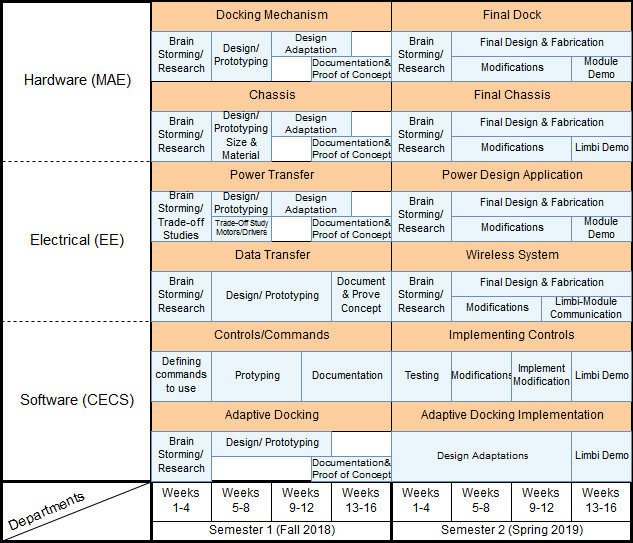JPL Challenge: Limbi Project
Written by Christine Leiterman. Verified by Vazgen Avakian
Table of Contents
1 Introduction
2 Mission Background
2.1 Limbi
2.2 Spacecraft Modules
2.3 Docking Mechanism
3 JPL Mission Objective
4 CSULB Mission Objective
5 Schedule
6 Resources
Introduction
This is a proposal for the mechanical and aerospace engineering (MAE), electrical engineering (EE) and computer engineering and computer science (CECS) departments of California State University, Long Beach (CSULB) to participate in an interdepartmental project with findings that NASA Jet Propulsion Laboratory (JPL) can utilize. This project will be completed in a two-semester senior design sequence.
Mission Background
Since 1981, robots such as the Canadarm has been controlled by astronauts to complete tasks that would be unsafe for astronauts to do on their own, such as repairing satellites and moving cargo. For more complicated tasks, automation would be more effective than being controlled by humans. NASA JPL has proposed using a reconfigurable robot that could be automated to participate in similar tasks as well as constructing spacecraft.
Limbi
A limbi is a multi-jointed robot that can attach itself to other limbis in various configurations to construct spacecraft or fix space structures. Limbi can also attach to spacecraft modules or space structures to complete these tasks. JPL implemented a prototype that attaches to makeshift spacecraft modules and connects these modules together, demonstrated in the video included below.
Spacecraft Modules
The spacecraft modules would make up a future spacecraft. One of these modules provides power for the Limbi and other modules. JPL’s design is cube-shaped and provides power through the docks that are connected by electromagnets.
Adapted from “An Untethered Mobile Limb for Modular In-Space Assembly” presentation by NASA Jet Propulsion Laboratory (2016). Received from Sawyer Brooks.
Docking Mechanism
The docks on the limbi and modules allow for any arrangement of limbi and module connections. JPL’s design uses electromagnets, as shown in the video. When the limbi is moving, a force on the module is applied parallel to its surface. The electromagnetic force is not enough to counteract this force and eliminate compliance between modules. CSULB can contribute by developing interconnects that would improve the rigidity of the docking mechanism.
JPL Mission Objective
NASA JPL proposes to manufacture reconfigurable robots that can assemble and fix large space structures and spacecraft.
CSULB Mission Objective
California State University, Long Beach (CSULB) plans to contribute to the advancement of the limbi by developing mechanical interconnects and the power transfer. This technology would be demonstrated within the constraints of a two semester senior design project and budget.
Schedule
The three teams shall work together to build the limbi and modules. The teams shall inform each other every couple weeks on their progress in order for the parts to connect.
By the end of the first semester, the hardware team will submit documentation of proof that the chosen docking mechanism design shall allow the limbi to move the modules. The electrical team will submit a design for the power and data transfer that the modules can utilize to transfer power to the limbi and data between the modules and the limbi. The software team will submit documentation of proof that the limbi can dynamically dock and move modules based on information coming from different sensors.
By the end of the second semester, the hardware team will have built the limbi, the electrical team will have manufactured the modules, and the software team will have developed the software for the limbi to dynamically connect to the modules and move them together to build a structure.
More detailed plan on how the departments overlap can be viewed here.
Resources
Further information on this project and what has been done thus far can be viewed in the following links.

